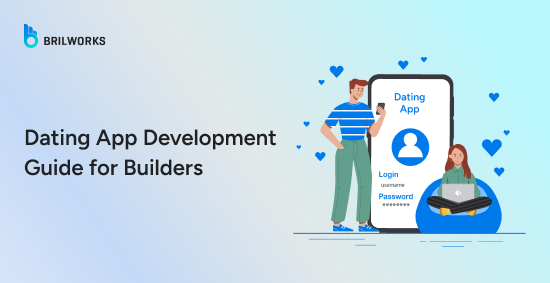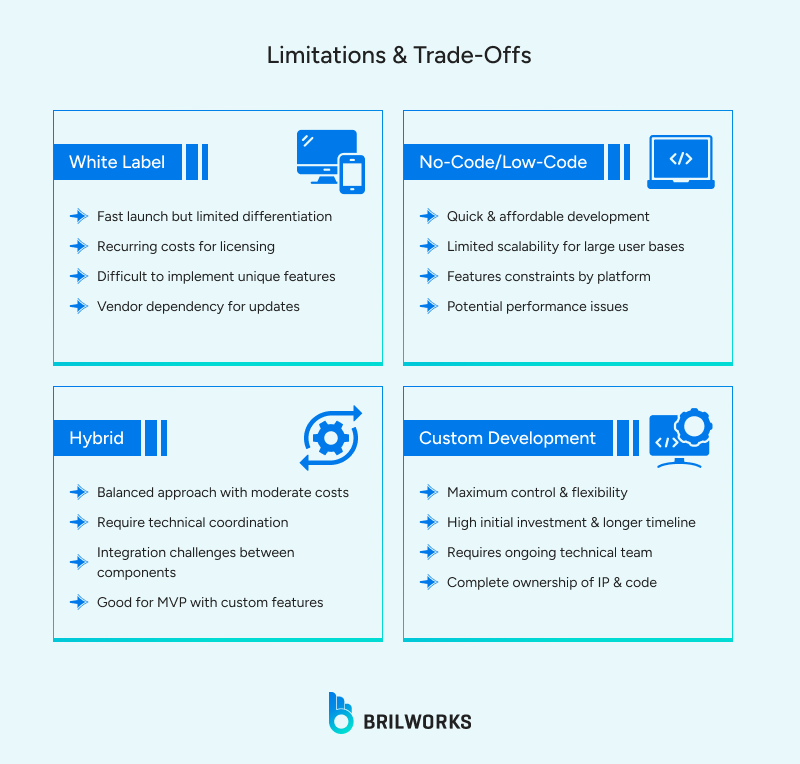COOPERATION MODEL
ARTIFICIAL INTELLIGENCE
PRODUCT ENGINEERING
DevOps & Cloud
LOW-CODE/NO-CODE DEVELOPMENT
FRONTEND DEVELOPMENT
CLOUD DEVELOPMENT
MOBILE APP DEVELOPMENT
LOW CODE/ NO CODE DEVELOPMENT
EMERGING TECHNOLOGIES








Data from Steady, Statista, and Business of Apps shows the dating app industry is still growing. User numbers are up, engagement is consistent, and virtual dating has become standard behaviour. The average user spends around 10 hours a week on these apps. Revenue projections suggest the market will keep expanding through 2028 and beyond. This means the niche has real opportunity but only if you build something that doesn't trap users in shallow swipe loops.
Most dating apps fail because they copy surface-level features without thinking about user psychology or long-term retention. If you're planning to build a dating app, you need to start with clarity about the type of experience you want to create and the audience you're targeting.
The dating app market has climbed steadily since the early 2010s. People have become comfortable using apps for discovery and conversations. Activity levels suggest users aren't leaving the space.
Year-over-year increases in both users and revenue show that the industry has matured into a stable sector. This stability matters because it means you're not entering a speculative bubble. You're entering a space where user behaviour is established and predictable.
Growth doesn't guarantee success. Users are active, but they're also quick to leave if something feels wrong. The difference between a successful app and one that dies in six months often comes down to understanding user expectations. People know what good matching feels like. They know what intuitive navigation looks like. They've tried multiple apps, so they have benchmarks.
Your app will be judged against Tinder, Bumble, Hinge, and others—whether you like it or not. This means you can't get away with unclear value propositions, or features that feel half-built.
Choosing the type depends on your target audience, the problem you're solving, and how much control you want over the matching process.
These match users based on proximity. The model works because people prefer connecting locally. But it requires density. Without enough users in one area, the experience feels empty.
Start with one region instead of trying to scale globally right away. Geolocation apps thrive in cities where population density is high and people are open to meeting strangers nearby. The challenge with this model is cold start. Getting enough users in one location to make the app feel useful. If someone opens the app and sees only three profiles within 50 miles, they won't come back.
This is why many geolocation apps launch with heavy localized marketing in one or two cities before expanding. The other challenge is safety. When you're matching people based on real-time location, privacy concerns become more prominent. Users need reassurance that their exact location isn't being shared publicly and that the app has proper reporting and blocking systems.
Users answer questions about interests, goals, and values. The app matches them based on alignment. This can improve match quality, but onboarding needs to stay simple. Too many questions and users drop.
Too few and the matching becomes useless. The best questionnaire apps balance depth with brevity. They ask enough to create meaningful matches but don't make onboarding feel like homework.
Some apps use progressive profiling, starting with a few core questions and adding more over time as users engage. This keeps the initial experience light while still gathering data for better matching.
The other advantage of questionnaire-based apps is that they attract users who are serious about finding compatible matches. People willing to answer 30 questions about their values and relationship goals are usually more invested than those who just want to swipe through photos.
A straightforward profile catalogue with minimal filtering. Users browse freely. This model depends on clean navigation, if the directory feels cluttered, people stop exploring. Open directories work well for niche communities where users want to see everyone in the network without algorithmic interference.
The downside is that it requires active user behaviour. There's no algorithm pushing profiles to users, so engagement depends entirely on how motivated people are to browse. This model also works better for smaller, tightly defined communities rather than mass-market apps.
Apps built for specific communities like fitness enthusiasts, pet owners, or shared interest groups. Since users already have common ground, conversations start easier. The app's design should reflect the niche—categories, tone, and flow need to match what the community expects.
Niche apps often have stronger retention because users feel like the app was built for them specifically. A running app that lets users filter by pace, race goals, and preferred running times feels more relevant than a general dating app with a "fitness" tag.
The challenge with niche apps is market size. You're deliberately narrowing your audience, so you need to validate that the niche is large enough to sustain the app. Some niches are too small to support a standalone app, but they can work as features within a broader platform.
Once you know the type, decide how you want to build it. The choice is between custom or white-label. Both have clear trade-offs, and the right choice depends on your budget, timeline, and how much control you need over the product.
You build from scratch. This usually takes 7 to 12 months and requires either an in-house team or outsourcing. Custom makes sense when you need full control—unique matching logic, specific flows, or particular scalability requirements. It offers maximum flexibility but comes with high costs and long timelines.
If your idea is straightforward or similar to existing apps, custom might not be worth it. Custom development is the right choice when your app has a unique value proposition that can't be achieved with prebuilt solutions.
For example, if you're building a dating app that integrates with wearable devices to match people based on biometric data, you'll need custom development. But if you're building a geolocation app with standard swipe mechanics, custom development might be overkill. The other consideration is technical debt.
Custom apps give you full control, but they also mean you're responsible for maintaining and updating the entire codebase. As your app scales, you'll need developers who understand your specific architecture. This can become expensive over time.
White-label apps are prebuilt. You get a ready solution and adjust branding, colors, and some flow elements. Deep customization is limited because the core is already built. You also can't change the tech stack.
But it's faster and cheaper for launching or testing ideas. Several companies offer white-label dating apps, including Brilworks. You can request a demo to see how the structure works. White-label makes sense if you want to test the market quickly without committing to a full custom build.
It's also a good option if your app idea is similar to existing dating apps and doesn't require unique technical features. The main limitation is flexibility. You're working within the constraints of the prebuilt platform, so if you need something highly specific, you might hit a wall. But for most dating apps, the standard features in a white-label solution are enough to validate the concept and build an initial user base.
If you're unsure which route fits your needs, a consultation helps clarify the decision. Most development companies, including Brilworks, offer discovery calls to help you map out requirements and decide whether custom or white-label is the better fit.
These are the essential components in a white-label dating app setup. The focus is smooth usage and better matching. Even if you go custom, these features form the baseline of what users expect.
Users log in through Facebook, Google, or similar options. This keeps onboarding fast. Social login also reduces friction because users don't need to remember another password. It also helps with profile setup since some information can be imported automatically. The downside is privacy concerns—some users don't want to connect their dating profile to their social accounts. Offering both social login and traditional email signup gives users flexibility.
Users add hobbies, values, photos, and other details. If they connect social accounts, some information imports automatically. The quality of profiles directly affects match quality, so encouraging users to fill out their profiles is critical. Some apps use gamification to incentivize complete profiles—offering badges, boosts, or visibility rewards for users who add more details. Others use prompts and guided questions to make profile creation feel less tedious.
The algorithm blends behaviour patterns, mathematical logic, AI signals, and location filters. It's not just a basic swipe system. If you need technical details, the team can walk through how it works. Good matching logic is the difference between an app that feels random and one that feels intentional. Users notice when matches are consistently irrelevant, and they leave. The best algorithms learn from user behaviour—tracking not just swipes but also message rates, response times, and profile interactions. This data helps refine future matches and improves the overall experience.
If you want a purely location-based version, that's available as a prebuilt setup. Location-based matching is straightforward to implement and works well for apps targeting local connections.
These features keep the app feeling active and users involved. Engagement is critical because dating apps live or die based on daily active users.
Includes badges, boosts, and virtual gifts. These add a layer of interaction beyond messaging. Gamification works because it gives users small wins and reasons to return. It also creates opportunities for monetization—users can pay for boosts or premium features to increase visibility.
A feed-style section where users post photos, videos, or updates. This creates more natural conversation starters. Feeds also increase engagement because they give users something to do besides swiping. Commenting on posts or reacting to updates feels less high-pressure than sending a direct message, which lowers the barrier to interaction.
Users can call through audio or video. This helps when they want more clarity before meeting in person. Voice and video features became more important after 2020 when in-person meetings were harder to arrange. Even now, many users prefer a video call before committing to a date. It's a safety and comfort feature.
Backend features that handle operations and safety. These aren't visible to users, but they're essential for running the app smoothly.
Push notifications for matches, messages, and activity updates. Notifications drive re-engagement, but they need to be managed carefully. Too many notifications and users turn them off or uninstall the app. The best notification strategies are personalized and based on user behaviour.
Controls for managing user accounts, content moderation, and app settings. A good admin panel lets you respond quickly to issues—removing fake profiles, banning abusive users, and adjusting app parameters without needing developer intervention.
Basic data protection and safety systems included in the core package. Security is non-negotiable for dating apps. Users share personal information, photos, and location data. If your app experiences a data breach, users will leave and your reputation is damaged permanently.
If you're building a dating app and need to choose between custom or prebuilt, Brilworks has worked on 150+ projects. We handle both white-label and custom development based on what your project requires.
Get In Touch
Contact us for your software development requirements
Get In Touch
Contact us for your software development requirements